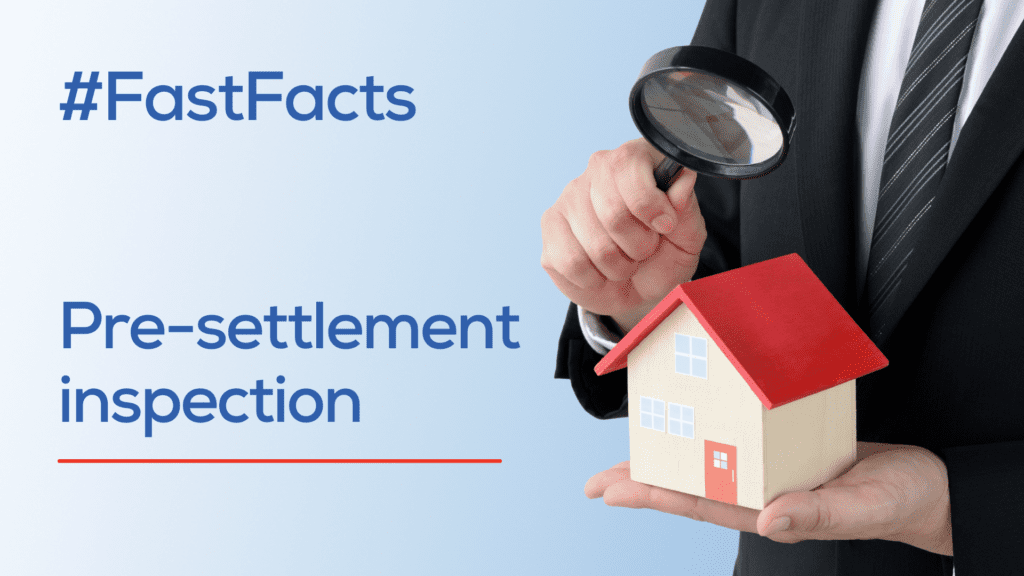Are you familiar with a pre-settlement inspection and how it can benefit you? It’s time to learn more!
A pre-settlement inspection is an essential part of the home-buying process. It’s your chance to ensure the property is in top-notch condition, just as it was when you initially signed the sale contract. This inspection is different from a pre-purchase inspection, which is more focused on structural aspects and defects. Instead, the pre-settlement inspection is all about certifying the current property’s state.
Why are pre-settlement inspections so crucial, you might ask? The condition of the property can change during the settlement period―which typically lasts between 14 and 120 days, with 30 to 60 days being the average. Damage or wear can happen, especially if the property isn’t vacant. Thus, this inspection allows you to confirm, without a shadow of a doubt, that the property remains as expected. The best time to conduct a pre-settlement inspection? Close to the settlement date but with enough time to handle any potential problems that may crop up. It’s important to ensure everything’s in order ahead of taking ownership. Each region has its specific rules regarding these inspections. Buyers in Victoria, for instance, can inspect the property during any reasonable time in the week before settlement. Always consult your conveyancer for the rules applicable in your area.
For a pre-settlement inspection, the buyer should be present, ideally along with a witness, like a real estate agent. You need to organise this visit beforehand with the seller. It’s essential to know you can’t legally enforce entry to the property without prior notice.

Don’t forget to check special conditions from your conveyancer, such as pest inspections or specific inclusions and exclusions. Review the contract of sale to ensure these conditions are met.
If you discover any issues, report them to your conveyancer immediately. They can negotiate with the vendor to have repairs made before settlement. If repairs cannot be completed in time, the sale price may be adjusted to cover the cost.
For the inspection, bring along the contract of sale to verify its contents and a camera to document any issues you find. If you encounter any problems, notify your conveyancer immediately. They can negotiate with the vendor for pre-settlement repairs. If these cannot be done in time, the sale price may be adjusted.

While conducting a pre-settlement inspection, it’s essential to be mindful of several common issues that buyers often encounter. Being aware of these can help you identify red flags early and take the necessary actions to address them.
Water Damage: One of the most frequent issues is water damage, which can manifest as stains on walls or ceilings, mould growth, or damp odours. Check beneath sinks, around washing machines, and in basements or attics for any signs of water infiltration.
Electrical Problems: Faulty wiring or non-working outlets are other prevalent concerns. Test all electrical outlets and light switches to ensure they are operational. Check for any exposed wires which can be hazardous.
Plumbing Issues: Dripping taps, slow drainage, and low water pressure can be indicators of underlying plumbing problems. Flush all toilets and run all taps, checking for leaks or ineffective drainage.
Heating and Cooling Systems: Malfunctioning heating or cooling systems can be troublesome, especially as their repair can be costly. Turn on all heating and air conditioning units to verify they work correctly and inspect for unusual noises or inefficient operation.
Structural Defects: Cracks in walls, ceilings, or foundations can signal significant structural issues. While hairline cracks might be normal, larger, more pronounced cracks should be examined closely.
Pest Infestations: Evidence of pests can range from droppings and nests to chew marks on furniture or wiring. Inspect corners, cabinets, and under appliances for any signs of unwanted critters.
General Wear and Tear: Properties experience general wear and tear over time, but significant damage to flooring, walls, fixtures, or fittings should be noted. Look for any changes since your initial visit, such as stained carpets or broken tiles.
Appliance Malfunctions: Ensure all included appliances, such as stoves, dishwashers, and microwaves, are in working order. Turn on each appliance to check its functionality and report any discrepancies.
Outdoor Areas: Don’t overlook the external parts of the property. Examine fences, sheds, and garages, ensure gate latches are working, and check for any damage to outdoor structures or garden fittings.
By anticipating these common issues and conducting a thorough inspection, you can address potential problems proactively, ensuring that your new property truly meets your standards and expectations. Always keep detailed records and communicate any concerns with your conveyancer to facilitate a smooth settlement process.
A pre-settlement inspection, also known as a final walk-through, is an opportunity for the buyer to inspect the property before finalizing the purchase. This allows buyers to ensure that the property is in the agreed-upon condition and that all specified repairs have been made.
It is advisable to conduct the pre-settlement inspection within a week before the settlement date. This timing ensures that any necessary repairs are still recent and that the property has not undergone any recent damage.
The buyer should attend the pre-settlement inspection, possibly accompanied by their real estate agent, a trusted friend or family member, or a professional inspector for additional support and expertise.
Yes, if you discover issues during the pre-settlement inspection, you can negotiate to have them fixed, ask for a price reduction, or request money be set aside in escrow to cover the cost of the repairs.
Bring a prepared checklist, basic tools (such as a flashlight and tape measure), a camera or smartphone for documentation, and a copy of the sales contract to verify repairs and inclusions.
If the property is not in the same or better condition as when you agreed to purchase it, you have the right to address the discrepancies with the seller. This may involve negotiating repairs, compensation, or adjustments to the settlement terms.
While not legally required, a pre-settlement inspection is highly recommended to protect your investment and ensure that you move into a property that meets your expectations.
If the seller refuses to address the issues, you may have grounds to delay the settlement or, in some cases, withdraw from the contract based on the terms outlined in your agreement. Always consult your conveyancer for legal advice in such situations.
By being well-prepared and knowledgeable about common pre-settlement inspection questions, you can confidently approach this crucial stage of the home-buying process

Avoid the pitfalls that can occur when purchasing property.
Services
About Us
Members Of

© 2025 Ownit Conveyancing
Website & Digital Marketing by KOA Digital
Services
About Us
B.Bus, GCAF, GAICD
Andrew has over two decades experience in high growth fast moving consumer goods, agribusiness and professional services. Supporting the Ownit team to deliver on client expectations, and implementing processes to scale the organisation, is a key focus for Andrew.
Andrew is a C-Suite leader with Chairman and Board experience. He has formal qualifications in Business, Applied Finance and AICD Company Directors Course.
